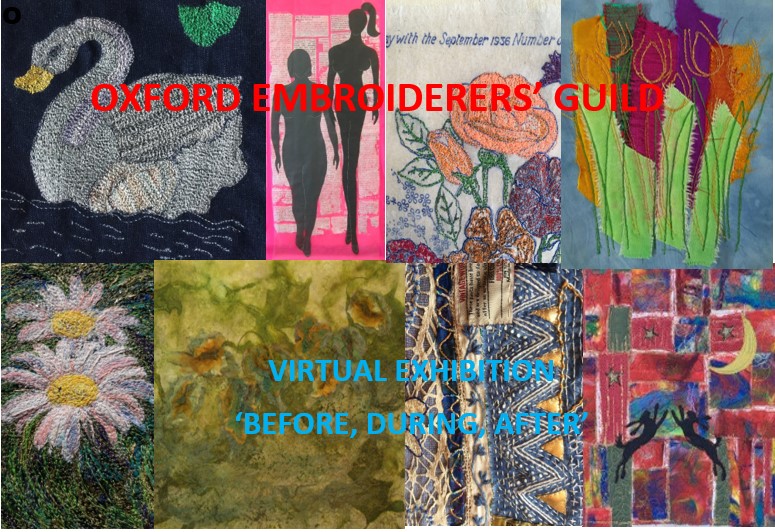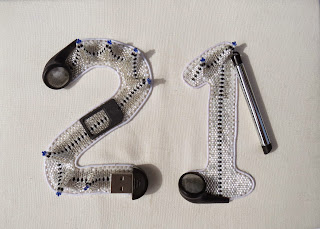Katie arrived with her fabulous display of hand-stitched work created during her time on the Royal School of Needlework 3 year course and a range kits she has designed. Also accompanying her were her very supportive partner and her adorable 5 month old baby, which we were all coveting! Katie was a very lively, humorous and personable speaker, who gave us a wonderful insight into what it was like to do the RSN course as she talked about the works on display that she had created during her time there.
Katie began by giving us a little of her background, indicating that she was the youngest of two children, but most importantly she was the ONLY girl grandchild in contrast to the 7 others who were all boys! Katie started on her textiles route at an early age, as her mum and grandmothers all did a variety of stitching, knitting, crochet etc. She began with simply sorting the colours of buttons, but soon progressed to darning – which became an underlying theme for her as she developed! At school the focus was more on machine work than any hand-stitching and for some reason Katie had never quite gone much beyond darning in the family arena. At 16 she chose A levels more suited to her preferred career route to archaeology, studying History, Psychology and English Literature. She also opted to take A level Textiles, but only as an added extra! It was during this period that she learned to recognise 'Beauty in everything' as her teacher taught her, including the detailed drawings she had to do of a freshly dismembered chicken carcass, where she appreciated the rich colours and textures she discovered there.
Despite being accepted to study Archaeology at York University, literally weeks before she was due to go she had a 'road to Damascus' moment and realised she had to instead pursue her interest in her much loved and never abandoned 'playing with fabrics and threads'. Despite her worries about breaking this volte-face to her parents, they merely laughed! They told her they’d realised textiles was ultimately her passion and what they had always believed she would do, but if they were to have suggested it to her she wouldn’t have listened to them!
©
Katie Pirson
Coupled with her textiles interests Katie’s continued love of history and English literature lead her to opt for a costume designing course at the London College of Fashion. She had a fabulous time exploring designs from ancient to modern, from theatre to film sets and much in between. At the conclusion of her course she managed to get the opportunity to design 150 costumes for a charity event with Cliff Richard, which she felt certain would enable her to dazzle everyone with her amazing costuming talents, thus setting her on the road to fame and fortune in the costume world. However, one should never count one’s costume success before the designs have arrived, as she discovered on learning that she was actually required to create 150 flesh-coloured thongs! This was hardly the chance to shine in the costume world that she had imagined!
After a time Katie began to hanker for some more hands on embroidery and initially struggled to find a suitable course, until she came across a leaflet for the Royal School of Needlework (RSN) 3 year course and realised this was absolutely the one for her! She had to endure a gruellingly rigorous 4 stage interview process, including one with the bursar who insinuated her parents might be less than willing to offer her accommodation during her course. She was one of only 4 students (apprentices) accepted by the RSN.
Katie had visions fuelled by her love of Jane Austen, which led to her imagining she would spend her days idyllically sewing dressed in period costume heretically sealed in the historical Hampton Court Palace setting. Although there were lovely views the reality was nothing like that or the original Victorian origins either! The view was the first thing she was introduced via a seeming initiation ceremony of going through various doorways, spiral staircases and ending up finally going through a trapdoor in the roof to emerge on top of the palace and they were left there to get on with a drawing that would be translated into a finished stitched sampler piece – she created a beautifully detailed image of the chimneys. She gave us in depth information on the types of threads she used in her various pieces, the plethora of stitches employed and the grounds they were worked on including French Linen Batiste at a staggering £92 for a piece about A4 sized! She indicated that they never just worked on one piece alone, but usually had at least 3-4 on the go at once, all exploring differing techniques. The most valuable part of the learning process was the understanding how to make a design that was workable for each method.
She discussed every stitch you could imagine (and maybe some you can’t!), but she said one of the most popular methods was the silk shading method, or painting with a needle, using long and short stitch. Although Katie felt it would be better named the long and longer stitch, as if you used too short a stitch it just ended up short and stubby. She indicated this was popular for altar frontals, regimental banners and restoration work. She showed us her example a beautiful poppy (chosen for her grandmother who worked for the British Legion), which actually included 32 different red threads, some only used for a few stitches!
©
Katie Pirson
She showed several examples of goldwork including a Tudor rose, the only design all students work on that is NOT designed by them! This work was important for Coronation Goldwork, a method including specific symbols on velvet since the 17th C. She also told us about showing this on an open day when some 'bright spark' refused to believe that she had actually sewn it all, arguing instead that it had to have been glued on and to prove his point he picked up her slate frame, turned it upside down shook it scattering all her materials sitting on top of it to the ground! There was a collective gasp from all of us on hearing this! We couldn’t believe anyone could be that stupid and inconsiderate!
©
Katie Pirson
They were required to do many different finished pieces using a range of methods. One piece they had to do used to be termed 'church work' but now altered to be a symbol, figure and animal. Due to a love of JRR Tolkein she created an eagle (in silk shading), a tree (in silver work) and JRR Tolkein in an armchair (tapestry silk shading). She also showed us quite a lot of white work and some Mount Melleck work too. She pointed out one piece that took 90 hours! She indicated they had to time every piece of work they created because this would be useful for later work when they would need to estimate costs/charges.
©
Katie Pirson
In the RSN final year Katie indicated that anything could fall into their laps! For example a famous Brazilian artist contacted them and wanted one of his watercolours translated into an embroidery for his large table! She also spent 350 hours on a christening robe! But they also had 'silly' things like restoring a small green felt teddy called Mr. Pickering and then recreating him in blue felt for the owner’s new grandson!
As a result of her RSN course Katie never went back to costumes, but now only does hand embroidery and also enjoys teaching. Katie finished her talk by giving us a few pointers gleaned through some excellent questioning by our members. She indicated that when they washed items they only used Ecover and Calgon water softener. They only do a cold wash in shallow basins, laying the fabric gently on the top of the water and allowing it to sink of its own accord over time, NOT pushing it down. If you push it down it can create watermarks. It is left to soak for an hour and then rinsed with a very gentle showerhead over it. Items can be washed many times using this method until the water is completely clean when poured away. When finished you just roll the textile in a towel to remove any excess moisture.
It was a joy to hear Katie’s talk and see her intricate work close up and to hear the context of how it was created.












